How to Acquire Backlinks Through Outreach
It’s important to acquire powerful links from leaders in your industry. Unfortunately, the process of acquiring those links is not as “step-by-step” as some of our previous tutorials. Why?
If we shared exact steps to acquire these links, people would be tempted to copy them verbatim and no one would see results. Instead, we’ve chosen to share with you the concept of outreach. We’ll let you do the work to see results!

In this chapter, you’ll understand the concept of backlink outreach and learn how to effectively implement backlink outreach for your site.
What is Outreach?
Outreach is a method of proactively acquiring backlinks to your website by contacting other website owners. The outreach process can involve any method of communication, but it typically happens via email and Twitter. By proactively reaching out to other bloggers, your chances of acquiring the link is much higher than if you just waited for them to find your content.
I wish I could tell you that the process is easy and quick. Unfortunately, it is not.
However, it is very effective. By investing a few hours of time, you can increase the number of people who visit your website. The more people who visit your website, the more people you can convert into paying customers. When you invest a few hours a month for the first few months you can acquire enough backlinks that you’ll be able to achieve higher rankings faster. Once you do this, you will only need to invest time in backlink outreach several times a year.
Where Do I Begin?
 Step 1: Find sites that are relevant to your website but are not direct competitors. The more relevant the links, the more valuable it will be and therefore the easier it will be for them to explain why they are linking to your website.
Step 1: Find sites that are relevant to your website but are not direct competitors. The more relevant the links, the more valuable it will be and therefore the easier it will be for them to explain why they are linking to your website.
To begin, we recommend brainstorming ideas of sites that may be similar to yours. For example, you can start by thinking about your city, state, complimentary products or products your customers may be purchasing. You should also consider thought leaders for your industry and brands of products you use.
For the purposes of this post and to guide you with an example, we will use a real estate agent, Tommy, based in Los Angeles.
Tommy’s list will look something like this:
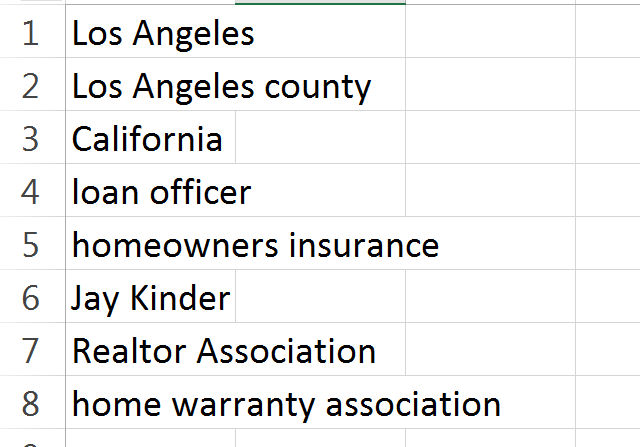
The more ideas you can come up with the more opportunities you will have.
Step 2: Find potential websites to acquire links from. To do this, we want to go to our trusty Google search and conduct a few searches. These searches use a hidden feature of Google called “Search Operators.” The search operators can be used to drill down on concepts with Google and provide you additional options to find webpages.
The search operator we will use is intitle:, which only shows pages that have a certain term in their title. The two terms we will use are “links” and “resources.”


You want to search for websites that link to resources. Ideally, they will list you as a resource. The majority of websites you will find will not list you, which is why this process can take some time. As you browse through the results, look at the websites that populate.
In our example, many of the results revolve around golf courses which is irrelevant to our business. We also found a page for an animal shelter and when we looked at the page, it only linked to other animal shelters. This would not be a good option to pursue.
After the first 15 pages, there weren’t any great options. So, we moved on to other terms. We combined two terms, “Los Angeles” and “homeowners insurance.” On the second page, there were a few insurance agents we could contact. We encourage you to search each term like we did, and copy the URLs that may be useful to a separate document. Once you gather a decent sized list, it’s time to move to the next step.
Determining If the Link is Worth Obtaining
Before you contact site owners, it’s important to decide if the link is worth acquiring. To do this we can check one of a few different sites to make sure that the site has some authority with the search engines.
We recommend using one of the following three sites:
Each site has a paid service (and they are not cheap). However, they let you use the tool for free for a few sites a day. You have the option of signing up and paying or simply alternating between the sites.
Take the first website on your list and enter the bare domain into the search bar. For example, if the complete URL is “http://www.whitehouse.gov/our-government/resources,” type in “whitehouse.gov.”


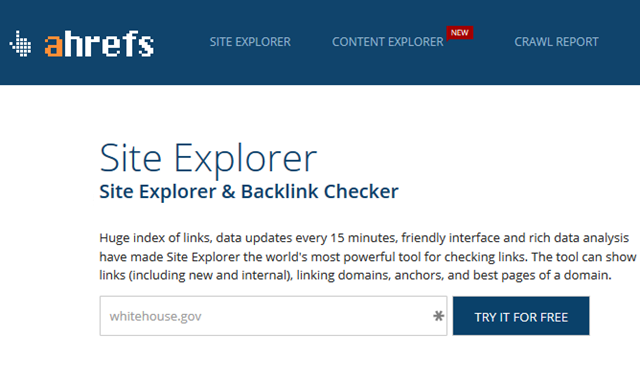
When the site comes back with a report, you can look at the metrics to decide if the link is worth acquiring. Each site has a different scoring system, but as a general rule, the higher the score, the better. Let’s look at whitehouse.gov, keeping in mind that this is one of the most popular sites on the internet. It’s virtually impossible to get a link on a site like this, but we’ll use it as an example anyway.
Let’s take a look at the results.
Majestic
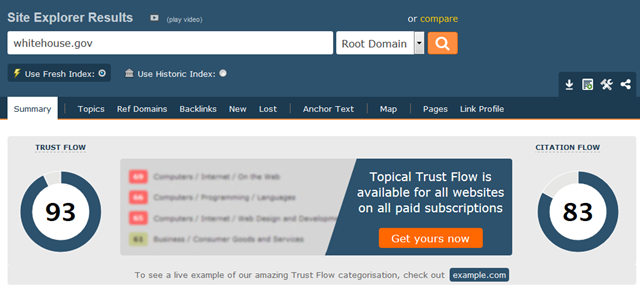
The 2 main scores they use are “Trust Flow” and “Citation Flow.” Trust flow is a measure of a site’s trustworthiness and Citation flow is a measure of the power and number of backlinks. A website that has over 5 in both of these categories is worth obtaining a link from. Note:You may want to be careful if the Citation flow is dramatically larger than the Trust flow because this can be an indication of spam.
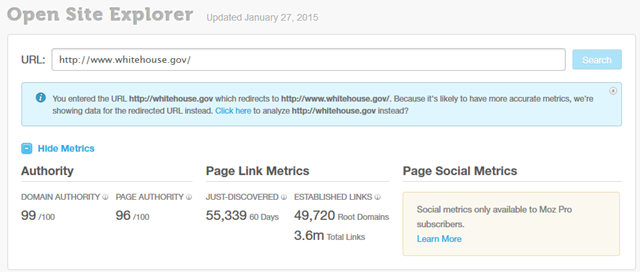
Open Site Explorer
In Open Site Explorer, the important metric to look at is Domain Authority. Any score of 7-10 or more for domain authority is a worthwhile link. However, having a decent page authority is also good.

Ahrefs
Ahrefs’ metrics are “URL Rank” and “Ahrefs Domain Rank.” The way Ahrefs calculation is done is differently than the other sites, so you want to look for a URL rank of 7-10. A domain rank over 20 is OK, but one of 30+ is ideal.
Why Would They Link to You?
This step takes some creativity. The more creative you are, the better the results.
You need to generate a reason for the sites to link to you. Generally speaking, the more value you create for their visitors, the better the chances they will be willing to link to you.
Here are a few ideas to get you thinking:
- Link substitutes. If they currently link to a website that no longer exists, you can let them know and they may be willing to add your link in as a substitute.
- Write content. Write a piece of content for their website that’s beneficial to their visitors. In our example, we may write something such as “Why You Need a Professional Insurance Agent When Purchasing a House” or “Buying a House? Get a Real Insurance Agent, Not an 800 Number.” Helpful hint: If you are creating content, we encourage you to generate 1-2 pieces before you begin to contact website owners. Most of them will quickly lose interest if it takes you too long to provide the content.
- Create a helpful guide. Write a guide that will be helpful to their visitors about your niche and offer to share it on their site.
- Discover errors. Let them know about an area of their site that isn’t working, and then ask them for a link.
- Browse websites for ideas. Look at their website for ideas. Each industry and site is different, so open your mind to ideas when you’re searching their site.
There are dozens of possibilities and opportunities for backlink outreach. The key? Be creative.

How to Contact Them
Now that you have your target websites and your offer is generated, it’s time to contact website owners. To begin, figure out who you need to contact. Then, find their contact information.
Step 1: Find their email address on their website. The easiest method is by finding it a “Contact Us” page. If it’s there, great! You just saved some time for yourself. If it’s not there, check the header and footer of the website instead.
Step 2: Conduct a Google search. Begin by entering the company name into Google and searching for websites that have the owner’s email listed.
Step 3: Look at Whois information. In case you’re unfamiliar with Whois, it’s the location of the contact information tied to a website owner. People are able to purchase privacy so their information isn’t publicly available. However, most people don’t.
To do this, go to whoisrequest.org. Enter their website address. Click “Search.”

On the next screen there will be a ton of technical data. You are looking for the contact information. There should be an email address like this:
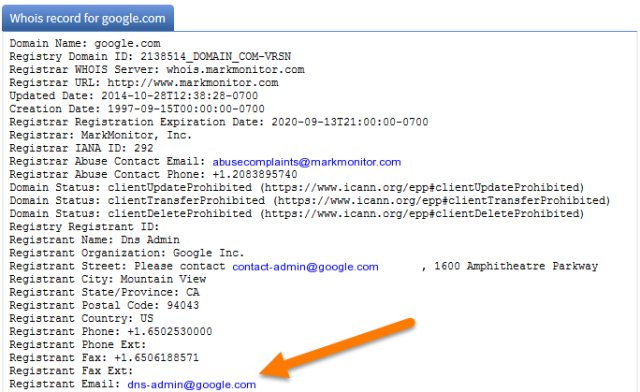
Make sure the email address appears to be tied to the business and not the company that built their website. For websites that have privacy enabled it will probably look something like this:

If you cannot find their email via these methods, you can attempt to find them on social media. You can do this by finding the name of the person you want to contact and then searching their name and the social media site. For example:
John Smith Facebook
John Smith Linkedin
John Smith Twitter
Once you find their profile, you can attempt to contact them via these sites.
Be sure to communicate clearly with them. You do not want to offend them! We recommend you begin with Linkedin, since it is primarily used for business.
Ultimately, you’ll need to decide if this work is worth it for you.
Before You Email…
There are two things to make sure you have in place before you start to contact people.
- Tracking method for contact information and communication. Hopefully, you’ve been saving the websites that you have found to a spreadsheet. This is typically the easiest method. Track names, emails, dates of contact, if they responded and any additional notes.
- Tracking method for opened emails. This isn’t required, but we recommend it. If you use Gmail, you can use a program such as Banana Tag, Yesware, or another great email tracking tool worth checking out is Right Inbox. These will tell you when and if the email is opened. Over time, you’ll see what subject lines are most likely to be opened, so you can use this data to fine tune your emails and achieve better results.
What to Say When You Contact Them
This part is equivalent to the sales pitch; your results will be directly correlated to your pitch. Remember, they do not know you, and more than likely this email is coming unexpectedly, so make sure it doesn’t look like a template or spam.
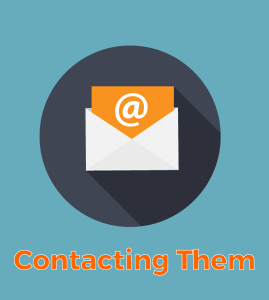 The goal of the subject line is to encourage them to open the email, not to sell them on the idea of linking to you.
The goal of the subject line is to encourage them to open the email, not to sell them on the idea of linking to you.
Remember these things:
- You have limited characters, so don’t waste them talking about you or your company.
- Be creative. Put yourself in their shoes. If you received the email you are thinking about selling would you open it? If not, then re-write it. You can be funny, entertaining, or whatever you think will spark their interest enough to open the message.
- Begin by addressing them by name and commenting about their website to show you have been to it.
- Remember, they are probably busy; don’t waste their time. Provide them a compelling reason why they should care about you and your email.
- Describe exactly what you’d like them to do:
- Link to you as a resource?
- Add your blog post to their site?
- Share your content on their social media?
- Use a real signature, with your name, company name, job title, website and phone number. Help them understand that you are a real person and not just some spammer wasting time.
- Don’t expect to hear back from everyone you message. In fact, chances are good you will not hear back from more than 20% of the people you contact. If you see that they’ve opened your e-mail, follow up again after a few days.
- Don’t be pushy. Inquire if they have any questions about your proposal.
Final Thoughts
This process is not the easiest, but the results you can achieve will be worth it.
Since this is such a challenging process, know that the majority of your competition will not be doing it, which gives you a competitive advantage. In addition to the link, you’re forming a relationship with the person which may help you to send business back and forth with one another.
Now it’s time to get started on acquiring some links. Good luck!
You’ve met your objective of understanding the concept of backlink outreach and learning how to effectively implement backlink outreach for your site.